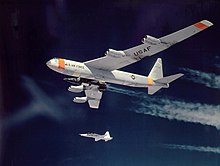North American X-15
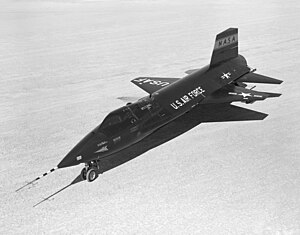 | |||||||||||||||||||||||||||||||||||||||||||||||||||||||||||||||||||||||||||||||||||||||
| Role | Experimental high-speed rocket-powered research aircraft |
|---|---|
| Manufacturer | North American Aviation |
| First flight | 8 June 1959 |
| Introduction | 17 September 1959 |
| Retired | December 1968 |
| Primary users | United States Air Force NASA |
| Number built | 3 |
The North American X-15 was a hypersonic rocket-powered aircraft operated by the United States Air Force and the National Aeronautics and Space Administration as part of the X-plane series of experimental aircraft. The X-15 set speed and altitude records in the 1960s, reaching the edge of outer space and returning with valuable data used in aircraft and spacecraft design. As of September 2015, the X-15 holds the official world record for the highest speed ever recorded by a manned, powered aircraft. It could reach a top speed of 4,520 miles per hour (7,274 km/h), or Mach 6.72.
During the X-15 program, 13 flights by eight pilots met the Air Force spaceflight criterion by exceeding the altitude of 50 miles (80 km), thus qualifying these pilots as being astronauts. The Air Force pilots qualified for astronaut wings immediately, while the civilian pilots were eventually awarded NASA astronaut wings in 2005, 35 years after the last X-15 flight. The only Navy pilot in the X-15 program never took the aircraft above the requisite 50 mile altitude and so as a result, never earned himself astronaut wings.
Of the 199 X-15 missions, two flights (both by Joseph A. Walker) qualified as true space flights per the international (Fédération Aéronautique Internationale) definition of a spaceflight by exceeding 100 kilometers (62.1 mi) in altitude.
Design and development
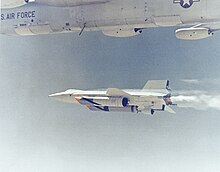 |
X-15A2, with sealed ablative coating, external fuel tanks, and ramjet dummy testThe X-15 was based on a co |
The X-15 was based on a concept study from Walter Dornberger for the National Advisory Committee for Aeronautics (NACA) for a hypersonic research aircraft. The requests for proposal were published on 30 December 1954 for the airframe and on 4 February 1955 for the rocket engine. The X-15 was built by two manufacturers: North American Aviation was contracted for the airframe in November 1955, and Reaction Motors was contracted for building the engines in 1956.
 |
X-15 after igniting rocket engine |
Cockpit and pilot systems
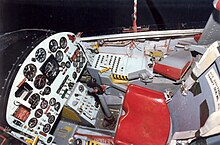 |
Cockpit of an X-15 |
Because the X-15 also had to be controlled in an environment where there was too little air for aerodynamic flight control surfaces, it had a reaction control system (RCS) that used rocket thrusters. There were two different X-15 pilot control setups: one used three joysticks; the other, one joystick.
The X-15 type with multiple control sticks for the pilot included a traditional rudder and stick, and another joystick on the left which sent commands to the reaction control system. A third joystick on the right side was used during high-G maneuvers to augment the center stick.In addition to pilot input, the X-15 "Stability Augmentation System" (SAS) sent inputs to the aerodynamic controls to help the pilot maintain attitude control.The reaction control system could be operated in two modes, manual and automatic. The automatic mode used a feature called "Reaction Augmentation System" (RAS) that helped stabilize the vehicle at high altitude. The RAS was typically used for approximately three minutes of an X-15 flight before automatic power off.
The second setup used the MH-96 flight control system which allowed one joystick in place of three and simplified pilot input. The MH-96 could automatically blend aerodynamic and rocket controls depending on how effective each system was at controlling the aircraft.
Among the many controls were the rocket engine throttle and a control for jettisoning the ventral tail fin.Other features of the cockpit were heated windows to prevent icing, and a forward headrest for periods of high deceleration.
The X-15 had an ejection seat that allowed ejection at speeds up to Mach 4 and/or 120,000 feet (37 km) altitude, although it was not used during the program. In the event of ejection, the seat had deployable fins which were used until it reached a safer speed/altitude, where it could deploy its main parachute. Pilots wore a pressure suit, which could be pressurized with nitrogen gas. Above 35,000 feet (11 km) altitude, the cockpit was pressurized to 3.5 psi (0.24 atm) with nitrogen gas, and oxygen for breathing was fed separately to the pilot.
Propulsion
 |
X-15 tail with XLR-99 |
The X-15 reaction control system (RCS), for maneuvering in low-pressure/density environment, used high-test peroxide (HTP), which decomposes into water and oxygen in the presence of a catalyst and could provide a specific impulse of 140 seconds.The HTP also fueled a turbopump for the main engines and auxiliary power units (APUs).Additional tanks for helium and liquid nitrogen performed other functions, for example the fuselage interior was purged with helium gas, and the liquid nitrogen was used as coolant for various systems.
Wedge tail and hypersonic stability
X-15 attached to its B-52 mother ship with a T-38 flying nearby |
The X-15 had a thick wedge tail to enable it to fly in a steady manner at hypersonic speeds.This produced a significant amount of drag at lower speeds; the blunt end at the rear of the X-15 could produce as much drag as an entire F-104 Starfighter.
A wedge shape was used because it is more effective than the conventional tail as a stabilizing surface at hypersonic speeds. A vertical-tail area equal to 60 percent of the wing area was required to give the X-15 adequate directional stability.Stability at hypersonic speeds was aided by side panels which could be extended out from the tail to increase the overall surface area, and these panels doubled as air-brakes.— Wendell H. Stillwell, X-15 Research Results (SP-60)
Operational history
 |
Neil Armstrong with X-15 number 1 |
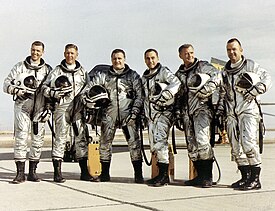 |
Members of the X-15 flight crew, left to right: Engle, Rushworth, McKay, Knight, Thompson, and Dana. |
Before 1958, United States Air Force (USAF) and NACA officials discussed an orbital X-15 spaceplane, the X-15B that would launch into outer space from atop an SM-64 Navaho missile. This was canceled when the NACA became NASA and adopted Project Mercury instead.
By 1959, the Boeing X-20 Dyna-Soar space-glider program was to become the USAF's preferred means for launching military manned spacecraft into orbit. This program was canceled in the early 1960s before an operational vehicle could be built. Various configurations of the Navajo were considered, and another proposal involved a Titan I stage.
Three X-15s were built, flying 199 test flights, the last on 24 October 1968.
The first X-15 flight was a captive-carry unpowered test by Scott Crossfield, on 8 June 1959. Crossfield also piloted the first powered flight, on 17 September 1959, and his first flight with the XLR-99 rocket engine on 15 November 1960. Twelve test pilots flew the X-15. Among these were Neil Armstrong, later a NASA astronaut and first man to set foot on the Moon, and Joe Engle, later a commander of NASA Space Shuttle test flights.
In a 1962 proposal, NASA considered using the B-52/X-15 as a launch platform for a Blue Scout rocket to place satellites weighing up to 150 pounds (68 kg) into orbit.
In July and August 1963, pilot Joseph A. Walker exceeded 100 km in altitude, joining NASA astronauts and Soviet cosmonauts as the first human beings to cross that line on their way to outer space. The USAF awarded astronaut wings to anyone achieving an altitude of 50 miles (80 km), while the FAI set the limit of space at 100 kilometers (62.1 mi).
On 15 November 1967, U.S. Air Force test pilot Major Michael J. Adams was killed during X-15 Flight 191 when the X-15-3, AF Ser. No. 56-6672, entered a hypersonic spin while descending, then oscillated violently as aerodynamic forces increased after re-entry. As his aircraft's flight control system operated the control surfaces to their limits, acceleration built to 15 g vertical and 8.0 g lateral. The airframe broke apart at 60,000 feet (18 km) altitude, scattering the X-15's wreckage for 50 square miles (130 km2). On 8 May 2004, a monument was erected at the cockpit's locale, near Randsburg, California. Major Adams was posthumously awarded Air Force astronaut wings for his final flight in X-15-3, which had reached an altitude of 50.4 miles (81.1 km). In 1991, his name was added to the Astronaut Memorial.
The second X-15A was rebuilt after a landing accident. It was lengthened by 2.4 feet (0.73 m), had a pair of auxiliary fuel tanks attached beneath its fuselage and wings, and a complete heat-resistant ablative coating was added. The plane was renamed the X-15A-2, and took flight for the first time on 28 June 1964. It reached its maximum speed of 4,520 miles per hour (7,274 km/h) in October 1967 with pilot William "Pete" Knight of the U.S. Air Force in control.
Five aircraft were used during the span of the X-15 program: three X-15s planes and two B-52 bombers:
- X-15A – 56-6670, 82 powered flights
- X-15A (later X-15A-2) – 56-6671, 31 powered flights as X-15A, 22 powered flights as X-15A-2, and 53 in total
- X-15A – 56-6672, 64 powered flights
- NB-52A – 52-003 (retired in October 1969)
- NB-52B – 52-008 (retired in November 2004)
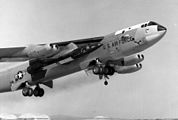
NB-52A (s/n 52-003), permanent test variant, carrying an X-15, with mission markings; horizontal X-15 silhouettes denote glide flights, diagonal silhouettes denote powered flights.

X-15 just after release.
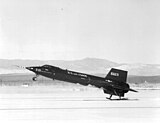
X-15 touching down on its skids, with the lower ventral fin jettisoned.

X-15A2 (56-6671) with external fuel tanks
Current static displays
X-15 at the National Air and Space Museum in Washington, D.C. |
- X-15A-1 (AF Ser. No. 56-6670) is on display in the National Air and Space Museum "Milestones of Flight" gallery, Washington, D.C.
- X-15A-2 (AF Ser. No. 56-6671) is at the National Museum of the United States Air Force, at Wright-Patterson Air Force Base, near Dayton, Ohio. It was retired to the museum in October 1969. The aircraft is displayed in the museum's Research and Development Gallery alongside other "X-planes", including the Bell X-1B and Douglas X-3 Stiletto.
Mockups
- Dryden Flight Research Center, Edwards AFB, California, USA (painted with AF Ser. No. 56-6672)
- Pima Air & Space Museum, adjacent to Davis-Monthan AFB, Tucson, Arizona (painted with AF Ser. No. 56-6671)
- Evergreen Aviation & Space Museum, McMinnville, Oregon (painted with AF Ser. No. 56-6672). A full-scale wooden mockup of the X-15, it is displayed along with one of the rocket engines.
Stratofortress mother ships
 |
NB-52B takes off with an X-15 |
- NB-52A (AF Ser. No. 52-0003) is displayed at the Pima Air & Space Museum adjacent to Davis–Monthan AFB in Tucson, Arizona. It launched the X-15-1 30 times, the X-15-2, 11 times, and the X-15-3 31 times (as well as the M2-F2 four times, the HL-10 11 times and the X-24A twice).
- NB-52B (AF Ser. No. 52-0008) is on permanent display outside the north gate of Edwards AFB, California. It launched the majority of X-15 flights.
Record flights
Highest flights
The FAI set the limit of space at 100 kilometers (62.1 mi). But in the 1960s, the U.S. Air Force considered an altitude of 50 miles (80 km) as the limit of space; U.S. Air Force and NASA pilots and crew exceeding that altitude at the time could be awarded the astronaut badge. Thirteen X-15 flights went higher than 50 miles, two of which exceeded 100 kilometers.| Flight | Date | Top speed | Altitude | Pilot |
|---|---|---|---|---|
| Flight 62 | 17 July 1962 | 3,831 mph (6,165 km/h) | 59.6 mi (95.9 km) | Robert M. White |
| Flight 77 | 17 January 1963 | 3,677 mph (5,918 km/h) | 51.4 mi (82.7 km) | Joseph A. Walker |
| Flight 87 | 27 June 1963 | 3,425 mph (5,512 km/h) | 53.9 mi (86.7 km) | Robert A. Rushworth |
| Flight 90 | 19 July 1963 | 3,710 mph (5,970 km/h) | 65.8 mi (105.9 km) | Joseph A. Walker |
| Flight 91 | 22 August 1963 | 3,794 mph (6,106 km/h) | 67.0 mi (107.8 km) | Joseph A. Walker |
| Flight 138 | 29 June 1965 | 3,431 mph (5,522 km/h) | 53.1 mi (85.5 km) | Joseph H. Engle |
| Flight 143 | 10 August 1965 | 3,549 mph (5,712 km/h) | 51.3 mi (82.6 km) | Joseph H. Engle |
| Flight 150 | 28 September 1965 | 3,731 mph (6,004 km/h) | 55.9 mi (90.0 km) | John B. McKay |
| Flight 153 | 14 October 1965 | 3,554 mph (5,720 km/h) | 50.4 mi (81.1 km) | Joseph H. Engle |
| Flight 174 | 1 November 1966 | 3,750 mph (6,040 km/h) | 58.1 mi (93.5 km) | William H. "Bill" Dana |
| Flight 190 | 17 October 1967 | 3,856 mph (6,206 km/h) | 53.1 mi (85.5 km) | William J. "Pete" Knight |
| Flight 191 | 15 November 1967 | 3,569 mph (5,744 km/h) | 50.3 mi (81.0 km) | Michael J. Adams† |
| Flight 197 | 21 August 1968 | 3,443 mph (5,541 km/h) | 50.6 mi (81.4 km) | William H. Dana |
Fastest recorded flights
 |
Key speed and altitude benchmarks of the X-15. |
| Flight | Date | Top Speed | Altitude | Pilot |
|---|---|---|---|---|
| Flight 45 | 9 November 1961 | 4,092 mph (6,585 km/h) | 19.2 mi (30.9 km) | Robert M. White |
| Flight 59 | 27 June 1962 | 4,104 mph (6,605 km/h) | 23.4 mi (37.7 km) | Joseph A. Walker |
| Flight 64 | 26 July 1962 | 3,989 mph (6,420 km/h) | 18.7 mi (30.1 km) | Neil A. Armstrong |
| Flight 86 | 25 June 1963 | 3,910 mph (6,290 km/h) | 21.7 mi (34.9 km) | Joseph A. Walker |
| Flight 89 | 18 July 1963 | 3,925 mph (6,317 km/h) | 19.8 mi (31.9 km) | Robert A. Rushworth |
| Flight 97 | 5 December 1963 | 4,017 mph (6,465 km/h) | 19.1 mi (30.7 km) | Robert A. Rushworth |
| Flight 105 | 29 April 1964 | 3,905 mph (6,284 km/h) | 19.2 mi (30.9 km) | Robert A. Rushworth |
| Flight 137 | 22 June 1965 | 3,938 mph (6,338 km/h) | 29.5 mi (47.5 km) | John B. McKay |
| Flight 175 | 18 November 1966 | 4,250 mph (6,840 km/h) | 18.7 mi (30.1 km) | William J. "Pete" Knight |
| Flight 188 | 3 October 1967 | 4,519 mph (7,273 km/h) | 19.3 mi (31.1 km) | William J. "Pete" Knight |
X-15 pilots
| X-15 pilots and their achievements during the program | |||||||
|---|---|---|---|---|---|---|---|
| Pilot | Organization | Total Flights | USAF space flights | FAI space flights | Max Mach | Max speed (mph) | Max altitude (miles) |
| Michael J. Adams† | U.S. Air Force | 7 | 1 | 0 | 5.59 | 3,822 | 50.3 |
| Neil Armstrong | NASA | 7 | 0 | 0 | 5.74 | 3,989 | 39.2 |
| Scott Crossfield | North American Aviation | 14 | 0 | 0 | 2.97 | 1,959 | 15.3 |
| William H. "Bill" Dana | NASA | 16 | 2 | 0 | 5.53 | 3,897 | 58.1 |
| Joseph H. Engle | U.S. Air Force | 16 | 3 | 0 | 5.71 | 3,887 | 53.1 |
| William J. "Pete" Knight | U.S. Air Force | 16 | 1 | 0 | 6.70 | 4,519 | 53.1 |
| John B. McKay | NASA | 29 | 1 | 0 | 5.65 | 3,863 | 55.9 |
| Forrest S. Petersen | U.S. Navy | 5 | 0 | 0 | 5.3 | 3,600 | 19.2 |
| Robert A. Rushworth | U.S. Air Force | 34 | 1 | 0 | 6.06 | 4,017 | 53.9 |
| Milton O. Thompson | NASA | 14 | 0 | 0 | 5.48 | 3,723 | 40.5 |
| Joseph A. Walker | NASA | 25 | 3 | 2 | 5.92 | 4,104 | 67.0 |
| Robert M. White** | U.S. Air Force | 16 | 1 | 0 | 6.04 | 4,092 | 59.6 |
Specifications (X-15)
 |
Other configurations include the Reaction Motors XLR11 equipped X-15, and the long version. |
- Crew: one
- Length: 50 ft 9 in (15.45 m)
- Wingspan: 22 ft 4 in (6.8 m)
- Height: 13 ft 6 in (4.12 m)
- Wing area: 200 ft2 (18.6 m2)
- Empty weight: 14,600 lb (6,620 kg)
- Loaded weight: 34,000 lb (15,420 kg)
- Max. takeoff weight: 34,000 lb (15,420 kg)
- Powerplant: 1 × Reaction Motors XLR99-RM-2 liquid propellant rocket engine, 70,400 lbf at 30 km (313 kN)
- Maximum speed: 4,520 mph (7,274 km/h)
- Range: 280 mi (450 km)
- Service ceiling: 67 mi (108 km, 354,330 ft)
- Rate of climb: 60,000 ft/min (18,288 m/min)
- Wing loading: 170 lb/ft2 (829 kg/m2)
- Thrust/weight: 2.07
